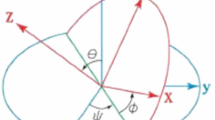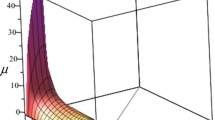Abstract
The motion of a rigid body about a fixed point, under the influence of an attractive force, is investigated from a physical basis. The errors in Euler's equations were shown, and appropriate equations were derived. It was also found that by nutation in the direction of decreasing θ only and oscillatory precession any two bodies, assumed as oblate spheroids, move in the direction of a zero external moment, as their stable equilibrium position. This position corresponding to the minimum kinetic energy of rotation is also reached by any two bodies which were initially acted upon by an external torque.
Similar content being viewed by others
References
Kuiper, G. P.: 1954,Proc. Nat. Acad. Sci. 40, 1096.
Marinescu, Gh. A.: 1968,Rev. Roumaine Sci. Tech., Ser. Mécan. Appl. 13, 853.
Thomson, W. T.: 1961,Introduction to Space Dynamics, 1st ed., Wiley, New York, pp. 147, 148.
Timoshenko, S., and Young, D. H.: 1948,Advanced Dynamics, 1st ed., McGraw-Hill, New York, p. 332.
Vâlcovici, V., Bălan, St., and Voinea R. (eds.): 1968,Mecanica Teoretică, 3rd ed., Editura Tehnică, Bucuresti, Romania, p. 721.
Author information
Authors and Affiliations
Rights and permissions
About this article
Cite this article
Marinescu, G.A. Physics of rotation. Astrophys Space Sci 8, 208–221 (1970). https://doi.org/10.1007/BF00650883
Received:
Issue Date:
DOI: https://doi.org/10.1007/BF00650883




